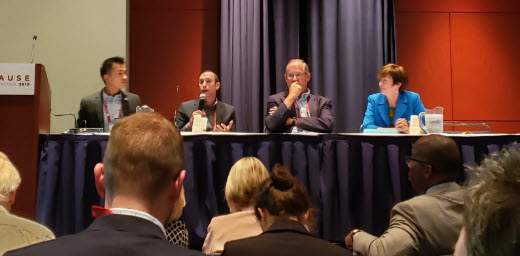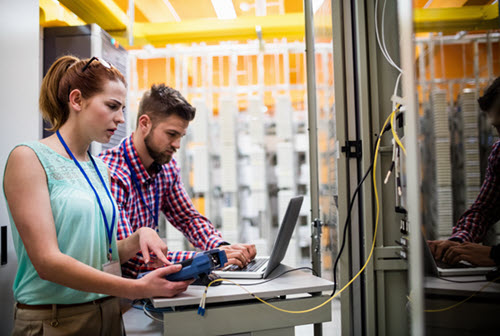The following session was presented at Educause 2019 by Vince Kellen, Chief Information Officer (CIO), University of California San Diego; Orlando Leon, CIO, California State University, Fresno; Helen Norris, Vice President & CIO, Chapman University; and Phil Ventimiglia, Chief Innovation Officer, Georgia State University.
To serve a growing and diverse student population, Georgia State University takes on more than its share of digital innovations in higher education. For Phil Ventimiglia, Chief Innovation Officer, achieving greater efficiencies is a must to provide the best experience across campus.
“We have to leverage technology,” Phil said. “There just aren’t enough people and staff to provide students everything they need otherwise.”
Easily record your screen with Snagit!
Snagit is the ultimate tool for recording presentations, creating video tutorials, or sharing quick updates.
Download Free TrialInnovation by another name?
Now named one of the most innovative universities in the United States, it’s not surprising that many of Georgia State’s changes qualify as digital transformation (DX). Phil, however, knows no single term can convey the multi-faceted layers of work needed for lasting change.
“The term ‘digital transformation’ itself is meaningless other than for marketing an ongoing concept in a new package. Innovation is a continual process,” he said.
Chapman University Vice President and Chief Information Officer Helen Norris holds a similar view. Mostly, Helen wants to make sure the term goes beyond the current buzz to communicate the full magnitude of its impact, and prefers a more universal term.
“I would focus more on innovation than digital transformation,” she noted. “With digital transformation, it sounds that tech is leading. Instead, strategy should be leading. Specifically, it should be rooted in the strategic plan of the university.”
Protect new ideas, together
As the third-fastest-growing research university in the country, Phil sees everyone at Georgia State contribute to an innovative mindset.
“You can’t say that some people are innovators and some are not,” he explained. “Everyone in the organization has to be focused on innovation.”
To that end, Georgia State encourages all faculty and staff to work together on new ideas. “We have a DNA within our university to experiment, to try new things,” he said. This often includes working cross-departmentally on challenging projects. “We have to step out of our silos. We work very closely across all areas.”
The teamwork aspect is especially important. “Innovation cannot be owned by anyone,” Phil said. “In my experience when you try to have one person drive innovation, it’s like having someone run up against a brick wall. Collaboration is what is true, and what works.”
Vince Kellen, Chief Information Officer (CIO) at the University of California San Diego, sees the activity as more selective.
“Innovation is a tricky thing,” he confessed. “Not everyone likes to do innovation. Some like to do it, and they shouldn’t.”
Sometimes, the opposite is also true, he explained. “Some innovate, and don’t know they’re doing it.”
For example, although not their goal, faculty who launched a new Cloud Optimization Center found that the pilot inadvertently turned up some groundbreaking new information and processes.
To avoid human nature’s tendency toward status quo, new ideas often need extra support.

“Putting innovation on the agenda is important,” Vince emphasized. “Sometimes the best innovations need extreme defense and protection. Sometimes other parts of the organization will try to kill that innovation.”
Vince also noted that, if not supported from the top-down, sometimes change agents themselves fall into the target as well. For change to survive, it’s important to defend it while it’s young.
“The people doing the innovation need the protection,” he counseled. “We shield them from the instincts of the organization to either execute [innovation] too early, or kill it.”
Relationships as resources
In some ways, smaller universities have an advantage when it comes to transitions. Helen noted that smaller environments can be more agile.
”You don’t have the same amount of bureaucracy to get the same things accomplished,” she explained.
Part of this dexterity comes from more well-established human connections. “Because you’re smaller, you personally know half of the faculty,” Helen said. “You can leverage those relationships as you do innovative things and create change.”
There are disadvantages to being at a smaller organization, though. “You have a smaller staff,” Helen noted. “You just don’t have the resources to do some of the fun things. So you do partnerships with vendors and others in the community.”
Vince cautioned that larger institutions have a similar mixed-bag of pros and cons, when it comes to digital transformation.
“We have the illusion of more resources at a larger university,” he said. “But innovation is ‘garage band’ stuff.”
With more than $1.4 billion in research funding per year, there are a lot of other distractions, and it can be hard to grab faculty’s attention. You have to find points of collaboration and know your faculty to promote lasting changes. Ideally, it can translate to an opportunity for the faculty or staff, to make their experience better, or better for their students. “Having relationships with those faculty is key,” he said.
Orlando Leon, Chief Information Officer, California State University, Fresno, agrees, but emphasizes the importance of campus leadership willing to take some risk.
“Digital transformation needs to be top-down and bottom up,” Orlando urged. ”It’s got to start somewhere. You’ve got to be able to lead this level of change.”
Even amidst resistance, it’s important to rally support, even if it means starting small. “Partner with colleagues,” Orlando advised. “You don’t have to start with jumping over the moon.”
Complexities with change
A key up-front challenge is to not chase after all the new digital solutions available. Although tempting, it often results in using a shiny tool for the wrong thing.
“I think everyone gets enamored with the technology and fails to understand that the complexities are enormous, Vince explained. “All of ed tech is consistently underestimating the last 10 percent of support needed for digital transformation.”
For projects that do make the cut, having a solid IT team helps. Phil noted that Georgia State typically does 40-50 new integrations per year, and that their strong IT team allows them to quickly integrate new technologies.
Similarly, a strong IT team can keep everything else running smoothly at the same time new systems are being installed. “Core systems still need to work,” Orlando said. “I encourage our teams to do all our core functions well.”

IT’s meta challenge — rework its own foundation
Higher education must scale an undeniable tech ‘hump’ to truly be in a great place for the digital transformation of today. Vince noted that getting rid of mainframe systems can be a huge leap forward.
“The biggest digital transformation is within IT work itself,” he said. “That will be moving from a ‘homebrew’ software engineering environment to DevOps, namely we’ll be managing data and analytics and no longer doing software development.”
Cloud services allow better focus on other program goals as well. “Undergraduate growth is a priority,” Vince said. “There are interesting strategies we’re putting together online.”
Phil noted that Georgia State focuses on the student perspective, aiming to make the entire student journey easier. “We’re dedicated to making a place where students can succeed,” he said.
The human element of change
In all types of process transformations, face-time with faculty is a necessity.
“In spite of the fact that it’s digital, the human touch is really important,” Helen explained. “You need to work digital projects hand-in-hand with the faculty who will be impacted.”
Supporting already-busy faculty ensures they have the intellectual and emotional incentive to go through tough change in the first place.
Phil agreed, noting that with most innovative changes being done not by research faculty but full-time faculty, his goals include welcoming those efforts in a way that matters to instructors. He wants to ensure instructors have help to work through issues. “We want to give them more support. When there are stumbling blocks, they need the time to go work through that,” he said.“We need to make sure we’re not penalizing risk.”
The human aspect is critical. “How do we make sure we’re shining a spotlight and they’re getting credit for the great work they’re doing?,” Phil asked. “Ultimately, we want them to have rewards and to progress their career.”
Vince agreed that nurturing the motivation to change is a fundamental component to encourage faculty to adopt new ways of doing things.
“How do humans commandeer tech to serve their social biological instincts?,” he asked. “Because that’s really what’s going on here. To keep the humanistic element and work from there.”
Transforming students with new digital skills
Phil notes that successful digital transformation should foster the next level of digital literacy in students. Albeit openly amenable to try new digital tools, the challenge is to provide the best tools and activities for each degree program.
“How do we get students ready to compete in this 21st century economy?,” he asked.“As leaders in higher education we are in the fourth industrial revolution and it’s fundamentally changing higher ed. We’re already seeing these glacial shifts. How we deliver teaching and learning is changing.”
For example, after launching a digital literacy pilot in the honors college, Georgia State students completed a visualization project using Tableau/mapping software to help them better understand the significance of a historical event. The university is exploring digital literacy paths that include experiential learning, project-based learning, and real-world projects in partnership with organizations within Atlanta. Phil sees an obligation to help usher in this change.
“It’s a continual wheel of how we move the needle,” Phil said. “How can we continually up-level students’ skills so they’re not just competitive, but they’re ahead. As the tech leaders, it’s incumbent on us to be that thought leader and ask how we can serve those students better to be successful in this new world economy,’” he said.
In Fresno, students at California State University are working with a wellness bot, doing interdisciplinary learning, and teaming up with pre-K12 students to study blockchain. Particularly in their geographical area, familiarity with digital tools can potentially make a big difference to these students.
“These skills are great. Only 11 percent of jobs in the valley require a four-year degree,” Orlando explained. “Our students need to be ready to avoid being replaced by automation.”
Working on the administrative IT side of things, Orlando tries to make it easy for instructors to know about new tools and resources — and awareness is growing.
“We find that faculty didn’t know they had this support,” he said. “Our capability to change and do things is increasing.”.

Better data to improve outcomes
Already, digital transformation has put processes in place that collect strategic information and use it to the advantage of student outcomes. Phil commented that Georgia State has seen a significant increase in graduation rates.
Notably, his team used data to help figure out which class times are most needed, and then determined how to optimally distribute classes to best use the prime time.
“We keep looking at what is the next piece we can look at, to get that next half-percent of improvement,” he said.
Change happens slowly
Vince said that not all changes will happen quickly, and that’s okay. While some things have changed significantly, others — such as face-to-face meetings — remain the same.
“Compared to the combustion engine for farmers, which led to 1,000% increased productivity, the digital transformation in higher ed is much more nuanced,” he said. “There’s digital infusion, but a lot of modest steps forward.”
A step-approach to change is another good way to set expectations. “Think of the SAMR model,” said Orlando. “First you substitute digital for paper-based. Technology is there today, you just have to do it.”
Perhaps most importantly, for all digital transformations, ensure everyone understands the true role of technology is to use data and systems to amplify the best parts of higher education.
“I see this as similar to what’s happening in retail,” Phil said. “There was lots of hype that all brick and mortar will go away. Instead, we see companies like Amazon building a physical presence. Digital has increased the value of retail, so it’s extended the relationship with the consumer.”
The same is true in higher education, as it expands possibilities in teaching and expands the choices of students.
As far as how to be successful with digital transformation, it takes many people working together toward the bigger picture. “It’s not *one* thing you need to do for DX success,” Phil noted. “It’s hundreds of things.”
Easily record your screen with Snagit!
Snagit is the ultimate tool for recording presentations, creating video tutorials, or sharing quick updates.
Download Free Trial


Share